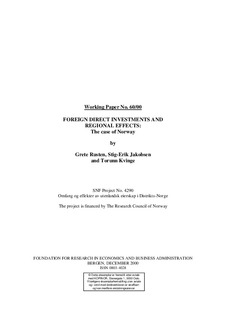| dc.contributor.author | Rusten, Grete | |
| dc.contributor.author | Jakobsen, Stig-Erik | |
| dc.contributor.author | Kvinge, Torunn | |
| dc.date.accessioned | 2006-09-01T07:07:04Z | |
| dc.date.available | 2006-09-01T07:07:04Z | |
| dc.date.issued | 2000-12 | |
| dc.identifier.issn | 0803-4028 | |
| dc.identifier.uri | http://hdl.handle.net/11250/166594 | |
| dc.description.abstract | Foreign direct investments (FDI) have had an important role in Norway since the start of the manufacturing age in the beginning of the 1900s. Traditionally these were mostly export-oriented manufacturing companies. However, shifts have taken place since the 1960s. In 1996 nearly ¾ of the employment in foreign majority owned companies are within trade or services mostly oriented towards the Norwegian market. This article aims to discuss more closely some business strategies and regional linkages among FDIs in order to focus on factors that may tempt such investments. This is followed by a discussion of regional policy implications. Empirical evidence is mainly based on case interviews from two research projects that took place in the period 1998-99. One main conclusion from the two research projects is that investments from abroad are a logical consequence of an increasingly international economy. The overall picture is that there seem to be many similarities between foreign and domestic firms concerning structural conditions, location and linkages. A market orientation with mergers and acquisitions as dominating investment strategy seem to be an important explanation for these findings. | en |
| dc.format.extent | 128723 bytes | |
| dc.format.mimetype | application/pdf | |
| dc.language.iso | eng | en |
| dc.publisher | SNF | en |
| dc.relation.ispartofseries | Working paper | en |
| dc.relation.ispartofseries | 2000:60 | en |
| dc.title | Foreign direct investments and regional effects : the case of Norway | en |
| dc.type | Working paper | en |
